Life After Discharge: The Real Dope – A Veteran’s Guide to Post-WWI Civilian Life (1919)
📌 Discover the historic guide that helped World War I veterans transition to civilian life. Where Do We Go From Here? The Real Dope (1919) provided returning soldiers with employment advice, government benefits, land settlement options, and re-enlistment details. Explore this rare WWI discharge handbook, packed with insights into the challenges and opportunities faced by millions of veterans.
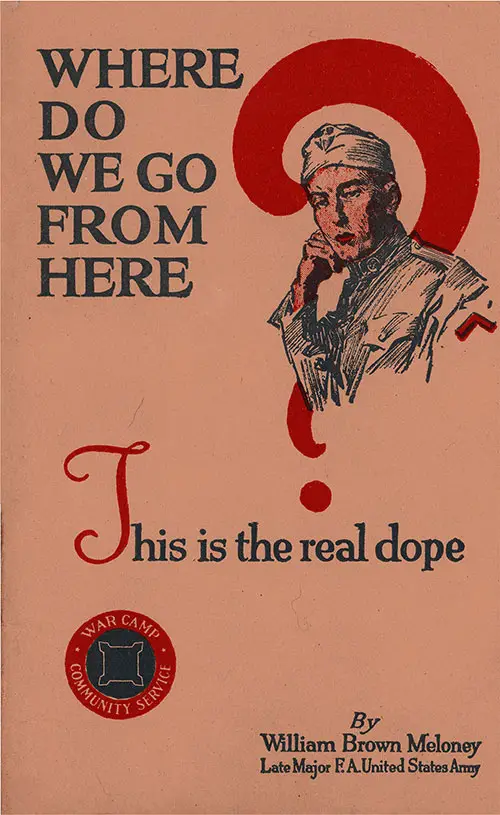
Front Cover, World War 1 Brochure "Where Do We Go From Here? This is the Real Dope," by Major William Brown Meloney, Ret. Field Artillery, United States Army, 1919. | GGA Image ID # 184ca8fb11
📜 Life After Discharge – The Real Dope (1919) 🇺🇸
🔍 A Soldier’s Guide to Post-War Civilian Life
This historically significant index page offers a fascinating look into the post-service transition for World War I veterans, as outlined in Where Do We Go From Here? This is the Real Dope, a popular handbook written by Major William Brown Meloney and published by the War Department.
William Brown Meloney wrote this handbook for soldiers: Where Do We Go From Here? The War Department published five million copies for Soldiers, Sailors, and Marines By War Camp Community Service. Discover why the World War 1 Discharge Guide Booklet was so popular.
The guide was widely distributed to millions of soldiers, sailors, and marines to help them reintegrate into civilian life, covering topics like:
✔ Job opportunities and re-employment programs 🏢
✔ Education and training options for veterans 🎓
✔ Government assistance and settlement programs 🌾
✔ Re-enlistment benefits and financial guidance 💰
✔ Military honors and wearing uniforms after discharge 🎖
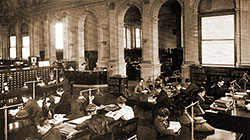
Educational and Professional Opportunities for Discharged Servicemen - 1919
Professional and scientific societies are addressing themselves with the task of reabsorbing professional men through notable organizations created for the purpose.
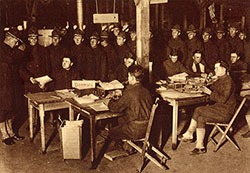
Getting a Job After Serving in the Great War - 1919
Notwithstanding these conditions, the country is prepared to reabsorb its fighting forces in civil life. The quickness of readjustment, however, depends on the spirit in which you meet your country.
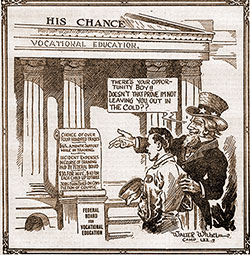
Government Programs & Training After Discharge - 1919
We, on our part, want to continue to serve you and your family until you are once more settled in civil life, with the same spirit in which we were ready to help them and you while you were under arms.

Living Off the Land - Options for Dicharged Soldiers and Sailors - 1919
At the end of that time, however, the estate you have acquired is far greater than the average estate of the man who works in a city trade or other profession.
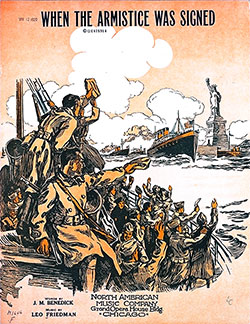
Options for Discharged Service Members - 1919
Any man without assurance of immediate civilian employment may remain in the service until he obtains work or the Government gets him a job.
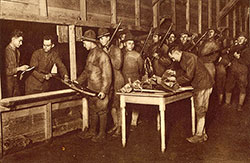
Re-Enlistment Options for Servicemen in the Great War - 1919
A furlough of one month is given to each man who re-enlists, which means a 30-day vacation with pay and allowances and the privilege of going home and returning to your station for a 1-cent a-mile railroad fare.
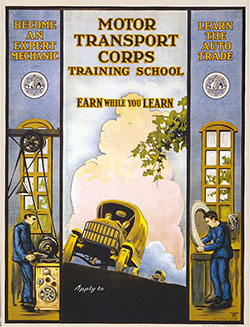
Soldier & Sailor Money Matters After Discharge - 1919
In addition to this travel allowance, officers and enlisted men are entitled to purchase a ticket home for two-thirds of the regular fare, providing that the purchase is made and the journey begins within 24 hours after being discharged.
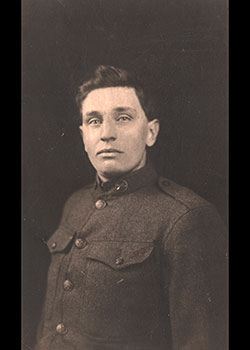
Military Uniform After Discharge or Reserve Status - 1919
If you desire to go home in uniform, it is your privilege to do so under a full grant of an act of Congress. You may wear your issue uniform as long as it hangs together.
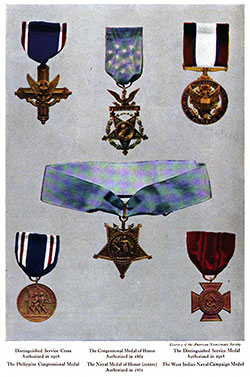
Victory Medals, Decorations, and Liberty Belts - 1919
The prescribed wound and service chevrons, unique individual decorations, such as The Medal of Honor, The Distinguished Service Cross, The Distinguished Service Medal, The Victory Medal, and the appropriate ribbon sections, are a part of the uniform.
💡 Why This Page Matters:
🔹 Captures the challenges of post-war reintegration for WWI veterans
🔹 Explores the U.S. government’s efforts to support returning service members
🔹 Provides valuable insight for historians, educators, and genealogists researching veteran experiences
🔹 Highlights a pivotal moment in U.S. history—the shift from war to peace
This page serves as a crucial resource for understanding the struggles and opportunities that shaped the lives of millions of returning veterans after the Great War.
📜 Key Highlights & Most Engaging Content
📖 "Where Do We Go From Here?" – The Must-Read Handbook for WWI Veterans
📌 Written by Major William Brown Meloney, this handbook became a trusted guide for soldiers reentering civilian life.
📌 The War Department distributed five million copies, ensuring every veteran had access to practical advice.
📌 Topics covered included employment, financial matters, land ownership, government aid, and military benefits.
📝 Why It’s Important:
This book was one of the earliest U.S. government efforts to help soldiers transition from war to peace.
It reflects the economic, social, and political realities faced by WWI veterans.
Understanding this guide helps us see how wartime service shaped veterans' futures.
🛠 Employment & Economic Opportunities for Veterans
📌 Getting a Job After the War (1919)
🔹 While there were concerns about reabsorbing millions of soldiers into the workforce, the U.S. government created training programs and employment initiatives.
🔹 The booklet encouraged soldiers to approach post-war life with a determined spirit.
🔹 Many professional societies helped reintegrate skilled laborers and technical workers into the economy.
📌 Government Programs & Training After Discharge
🔹 The government provided training and reemployment assistance for veterans.
🔹 Specialized programs for mechanics, engineers, and professionals helped returning soldiers transition into skilled jobs.
📌 Living Off the Land – Agricultural Options for Veterans
🔹 Soldiers were encouraged to pursue farming as a stable and rewarding career. 🌾
🔹 The government promoted land settlement programs, emphasizing self-sufficiency and economic independence.
📝 Why It’s Important:
🔹 Highlights the early 20th-century approach to veteran reintegration, focusing on work, land, and self-reliance.
🔹 Demonstrates how the U.S. government attempted to prevent mass unemployment after WWI.
🔹 Shows the value of trade schools and vocational programs for returning soldiers.
🎖 Military Benefits & Re-Enlistment Options
📌 Re-Enlistment Benefits for WWI Servicemen
🔹 Soldiers who re-enlisted received a one-month furlough (paid vacation) before reporting for duty.
🔹 Travel allowances were provided at a discounted rate of one cent per mile for returning home.
📌 Victory Medals, Decorations & Wearing Uniforms After Discharge
🔹 Veterans could proudly wear their service uniforms as long as they remained in good condition.
🔹 Soldiers were awarded chevrons and medals, including:
🏅 Distinguished Service Cross
🏅 Congressional Medal of Honor
🏅 Distinguished Service Medal
🏅 Victory Medal
📝 Why It’s Important:
- Shows how the military honored and recognized returning veterans.
- Re-enlistment benefits gave soldiers an incentive to remain in service.
- Many of these wartime medals and decorations are still revered today.
📸 Noteworthy Images & Their Significance
📷 Front Cover: "Where Do We Go From Here? This is the Real Dope" (1919)
🔹 One of the most widely distributed post-war booklets, providing veterans with crucial guidance.
📷 Soldiers in Training at Camp Dix Receiving Honorable Discharge Papers
🔹 Symbolizes the transition from active duty to civilian life.
📷 "There's Your Opportunity Boy!!" (Recruitment Poster, 1919)
🔹 Encouraged soldiers to take advantage of government programs and economic opportunities.
📷 Medals and Awards: Distinguished Service Cross, Medal of Honor, Victory Medal
🔹 A reminder of the sacrifices made by WWI veterans and the honors they received.
🎯 Relevance for Different Audiences
📌 🧑🏫 For Teachers & Students:
✔ Great primary source for studying WWI veteran reintegration.
✔ Encourages discussions on government responsibility for veterans.
✔ Explores early workforce challenges for returning soldiers.
📌 📚 For Historians & Military Researchers:
✔ Provides direct insight into post-WWI veteran affairs.
✔ Explains the economic and political shifts caused by the war’s end.
✔ Highlights how the U.S. handled mass military discharges and employment.
📌 🧬 For Genealogists & Family Historians:
✔ An essential resource for those researching WWI ancestors.
✔ Many veterans would have received this guide—tracing its influence on family history.
✔ Understanding medals, discharge papers, and job programs can help reconstruct a veteran’s post-war life.
🌟 Final Thoughts: A Crucial Document in Veteran History
📌 Where Do We Go From Here? The Real Dope (1919) is more than just a pamphlet—it’s a window into the lives of returning WWI soldiers.
📌 This collection highlights the government’s efforts to reabsorb veterans into society, offering job training, land programs, and re-enlistment incentives.
📌 For historians, genealogists, and educators, this resource provides invaluable insights into the post-war experiences of U.S. soldiers.
🔍 If you're studying World War I, veteran affairs, or early 20th-century America, this page is an essential read. 🇺🇸📜
